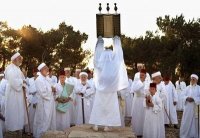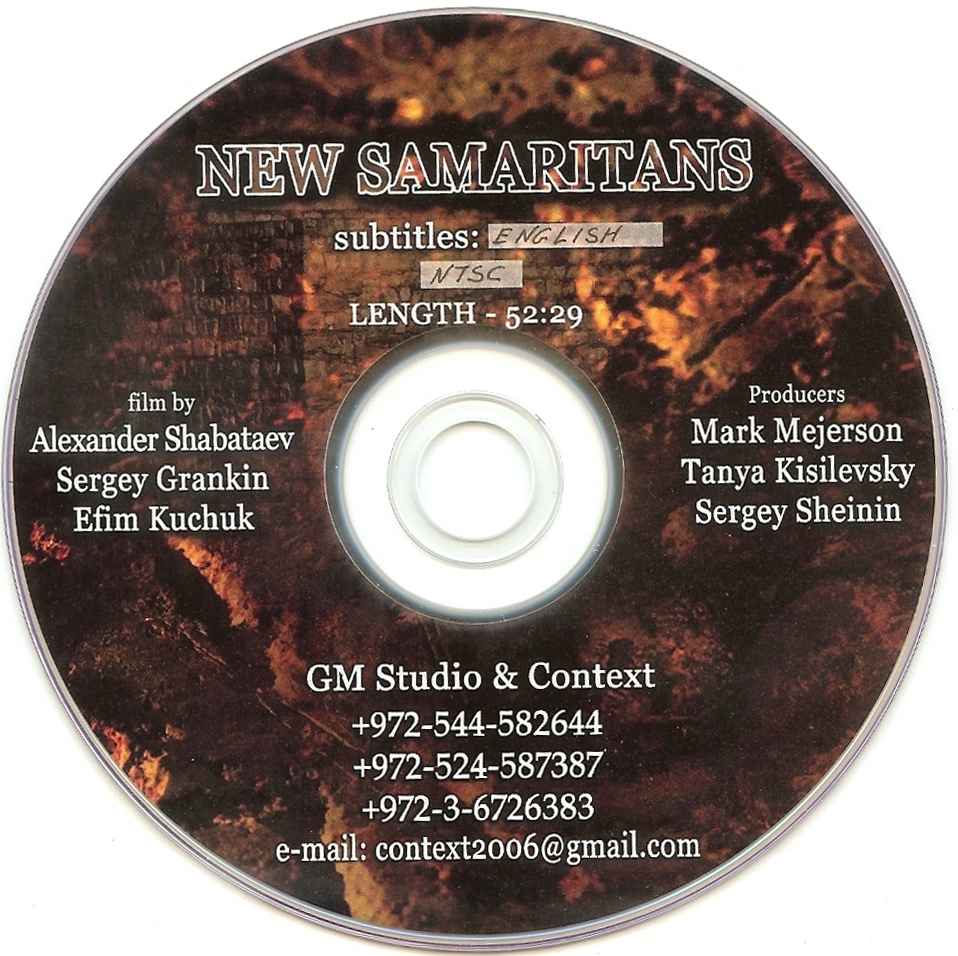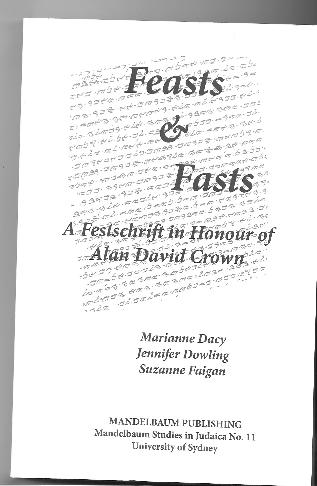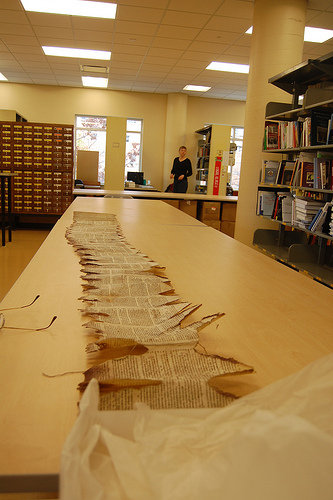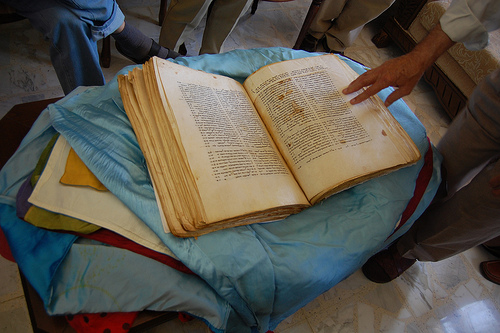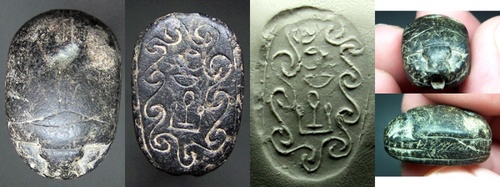
|
September/October 2009 |
Vol. IX - No.1 |
|
|
In This Issue · Scroll · Archive 2.0 · Archive Watch · Samaritan Culture · Joseph · Palestinian Arab Justice · Web Links · Publications · Books for sale
The
Samaritan Update, is a Bi-Monthly Internet Newsletter -----
Editor: Shomron
Co-Editor: Osher
Sassoni
Staff Writer:
Staff Photographer:
Staff Translator:
Special Contributors: ----
Contact information:
Subscribe To the Newsletter -The
Samaritan Update. Sign Up ! The Samaritans call themselves Bene-Yisrael (“Children of Israel”), or Shamerim (“Observant Ones”) Samaritan Studies and Related Conferences:
Samaritan Studies (EABS)2010 International Meeting
Meeting Begins:
7/25/2010 Call For Papers Opens: 10/1/2009
Update on the English Translation of the Samaritan Pentateuch from Logos Unknown publication date
Keep Up with the Samaritan Basketball team on FANS of Samritan basketball team
Community Youth Club Samaritan on Facebook.com SAMARITAN MYTHسطورة السامريةהאגדה השומרונית الا
A group of young Samaritans people who is interested in their culture, heritage and the future of their small community, we establish an association which is called Samaritan myth. This association is aimed on the definition of Samaritan's culture and heritage the internal and external one. Can be found on
and see Smaritan Blogspot
Important Links
Samaritan Museum on Mount Gerizim.
New Samaritans- A DOCUMENTARY on Samaritan brides from the Ukraine
Have you
purchased your book lately? Notices Of The Modern Samaritans: Illustrated By Incidents In The Life Of Jacob Esh Shelaby (1855) by Jacob Esh Shelaby and Edward Thomas Rogers (Paperback - Mar 20, 2009) Feasts &
Fasts, A Festschrift in Honor of Alan David Crown Available from
www.mandelbaum. New Samaritans- A DOCUMENTARY on Samaritan brides from the Ukraine Finnish Arabic Dictionary by H. Shehadeh here for article in Arabic
Forth Coming Books The English Translation of the Samaritan Pentateuch The first-ever English translation of the Samaritan Pentateuch, prepared by Benyamin Tsedaka WILL be published by Logos. The book shall be published near the end of this year. We shall keep you informed when we learn more.
Book Has New Publication Date SAMARITANS' PAST AND PRESENT: Current Studies (Deuterocanonical and Cognate Literature Studies) (Hardcover) by Menachem Mor (Editor) will now be on sale November 30, 2009 from the Publisher, Walter de Gruyter.
Jews and Samaritans: The Origins and History of Their Early Relations, by Gary Knoppers, (Oxford University Press, 2010) 192 pages; 6-1/8 x 9-1/4; ISBN13: 978-0-19-532954-4ISBN10: 0-19-532954-6 Hardcover, Expected: 4/15/2010 Gary Knoppers Professor of Classics and Ancient Mediterranean Studies, Religious Studies, and Jewish Studies, Pennsylvania State University
|
Samaritan Scroll Previously unknown (mislabeled and in library storage since at least 1927, recently rediscovered by Dr. David Gilner) almost complete 1145 CE Samaritan scroll of Deuteronomy, one of the oldest manuscripts of its kind in the world. Scroll is stitched sheets of, finely scraped parchment and originates from the Samaritan community in what is now present day Ashkelon. The presumed fire damage remains to be carbon dated. Klau Library, HUC-JIR, Cincinnati, Ohio, Wednesday, November 4, 2009.
http://www.flickr.com/photos/ridolfo/with/4075481619/ Archive 2.0: Imagining The Michigan State University Israelite Samaritan Scroll Collection as the Foundation for a Thriving Social Network
14th Century Samaritan Pentateuch / One piece of cloth for each generation, roughly sixty generations in the same family / Mt. Gerizim, Palestinian Authority. 5/25/2009 http://www.wide.msu.edu/content/archive/ The Samaritan Archive BlogArchive 2.0 Project Wraps Startup Phase, Whitepaper Published - September 4, 2009 - by Bill Hart-Davidson With the submission and publication of a whitepaper entitled "Archive
2.0: Imagining The Michigan State UniversityIsraelite Samaritan Scroll
Collection as the Foundation for a Thriving Social Network," the Archive
2.0 project team officially wrapped up the startup phase of their efforts
today. Jim Ridolfo, graduate of Michigan State University's Rhetoric &
Writing program and Assistant Professor at the University of Cincinnati is the
lead author of the report. Mike McLeod and Bill Hart-Davidson
from WIDE are also authors on the report.
The whitepaper is one of the deliverables required by the National Endowment for the Humanities Office of Digital Humanities, the agency that provided funding for the initial phase of work on the project. The whitepaper reports on the project's origins and the history of both the Samaritan people and the collection of texts at the center of the project as well as the activities that took place over the nine month period of funding in 2008-09. The paper notes that the title of the project - Archive 2.0 - is "more than simply adding the technological affordances of Web 2.0 to atraditional archive" it is also an opportunity for "reconsidering the very nature of anarchive, both what it is and what it does." Ridolfo, McLeod, & Hart-Davidson lay out recommendations for what Archive 2.0 projects should aspire to, including
The team hopes to continue the work begun in the startup phase of the project, working on future efforts to realize these goals in connection with the Warren-Chamberlain archive of Samaritan texts at MSU and also with other cultural stakeholder communities. http://www.wide.msu.edu/content/blog.php?id=2 http://wide.msu.edu/content/archive/ ~~~~~~~~~~~~~~~~ Archive Watch: Good SamaritansThe Samaritans of biblical fame still exist, although their numbers are small: The current community, split between Holon, Israel, and Mount Gerizim in the West Bank, numbers just over 700 people. In 1901, a Michigan industrialist named E.K. Warren traveled to the Middle East and was asked to bring home a collection of sacred Samaritan objects for safekeeping. The objects include prayer books and centuries-old versions of the Samaritan Pentateuch, or Torah, which has some significant differences from the Jewish Pentateuch. The collection has been housed ever since at Michigan State University. Read more- http://chronicle.com/blogPost/Archive-Watch-Good-Samaritans/8138/ ~~~~~~~~~~~~~~~~Samaritans Culture and Heritage Exhibition معرض التراث والثقافة السامريهبعد الحصول على موافقة ادارة جامعة النجاح الوطنية لاقامة المعرض الثاني حول
الثقافة والتراث السامري في الحرم الجديد المقرر اقامته عند نهاية الشهر
الحالي ، تلقت الجمعية كتاب من ادارة جامعة بيرزيت ترحب فيه باقامة معرض
للتراث السامري ومن المتوقع اقامته عند مطلع العام القادم From SAMARITAN LEGEND האגדה השומרונית الاسطورة السامرية http://www.facebook.com/home.php?#/group.php?gid=48487462187 وزيرة السياحة والآثار تفتتح معرضا للطائفة السامرية في نابلس http://www.alquds2009.org/atemplate.php?id=1379 ~~~~~~~~~~~~~~~~Joseph and the Egyptian Coins? by Dr. Ben Witherington The phone call was
urgent. Can you do an interview at 5:15 about some coins found in Egypt that
are claimed to be from the era of Joseph and even perhaps with his picture on
them? Here is the link to the initial story in the Jerusalem Post--
http://www.jpost.com/servlet/Satellite?cid=1253820674074&pagename=JPost/JPArticle/ShowFull
http://blog.beliefnet.com/bibleandculture/2009/10/joseph-and-the-egyptian-coins.html ~~~~~~~~~~~~~~~ A Case of Palestinian Arab
Justice between Minority and Majority The following Arabic short story
about the Samaritan high priest Salama b. Ghazal b. Ishaq b. Sadaqa was
written by the late high priest Ya‘qub b. ‘Uzzi in 1960. Salama (1784-1855)
actually served as a high priest between the years 1799 and 1826 and all high
priests who followed him were his offspring. After the death of his father in
1787, the Samaritans lived about twelve years without a high priest because
the only heir, his son Salama, was too young to take the office of high
priesthood. At the age of nine, the 23rd of January 1793 the orphaned Salama
started to copy the Samaritan Torah. Unfortunately, only one folio of that
Torah has survived in Firkovich Sam II B 55 at the National Library of Russia
in St. Petersburg. ~~~~~~~~~~~~~~~~ Web Links Le Garizim, mont sacré des
Samaritains The Cohen Gene, the Samaritans and the Ten Lost Tribes Levi's Jeans or Levis' Genes http://menachem.info/Blogs/026.htm Complete List of Biblioblogs http://biblioblogtop50.wordpress.com/biblioblogs/ Jewish temple found in ancient port city at Lycian site Ancient Samaritans celebrate different Sukkot in West Bank by Saud Abu Ramada, Hua Chunyu, Emad Drimly NABLUS, West Bank, Oct. 5 (Xinhua) -- As Jewish people all around Israel are celebrating their traditional feast of Sukkot (Feast of Tabernacles), in northern West Bank, Samaritans, a small religious sect who consider themselves descendants of the ancient northern Kingdom of Israel, are also celebrating Sukkot, but in a somehow different way. http://news.xinhuanet.com/english/2009-10/06/content_12185413.htm
Lipschits, Oded, Gary N. Knoppers, and Rainer Albertz, eds. Judah and the Judeans in the Fourth Century B.C.E. http://www.bookreviews.org/pdf/6106_6517.pdf ~~~~~~~~~~~~~~~~~ New PublicationsThe Book of Enlightenment for the Instruction of the Inquirer (Classic Reprint) (Paperback)~ High Priest of the Samaritans Jacob Ben Aaron (Author) Paperback: 104 pages Publisher: Forgotten Books (October 29, 2009) Language: English ISBN-10: 1440058679 ISBN-13: 978-1440058677 Product Dimensions: 9 x 6 x 0.2 inches Paperback: 76 pages Publisher: Alphascript Publishing (October 1, 2009) Language: English ISBN-10: 6130051050 ISBN-13: 978-6130051051 Product Dimensions: 8.7 x 5.9 x 0.2 inches Paperback: 182 pages Publisher: Kessinger Publishing, LLC (September 24, 2009) Language: English ISBN-10: 1120130492 ISBN-13: 978-1120130495 Product Dimensions: 9 x 6 x 0.4 inches
Hardcover: 250 pages Publisher: Walter de Gruyter (November 30, 2009) Language: English ISBN-10: 311019497X ISBN-13: 978-3110194975
The Origin of the Samaritans (Supplements to Vetus Testamentum) (Hardcover)~ Magnar Kartveit seen for sale for $123.98-185.00 Hardcover: 405 pages Publisher: Brill Academic Publishers (August 15, 2009) Language: English ISBN-10: 9004178198 ISBN-13: 978-9004178199 ~~~~~~~~~~~~~~~~~
Books For Sale Palæstra linguarum Orientalium : hoc est : quatuor primorum capitum Geneseos, I. textus originalis tam ex Judæorum quàm Samaritanorum traditionibus. II. Targumim seu paraphrases Orientales præcipuæ, nempe I. Chaldaicæ, (Onkelosi, Jonathanis et Hierosolymitana) II. Syriaca, III. Samaritana, IV. Arabica, V. Æthiopica, VI. Persica omnia cum versione Latinâ, ex Bibliis polyglottis Anglicanis maximam partem desumta & eo fine seorsum edita, ut & linguarum studiosi habeant, in quibus sese exerceant, et alii præstantiam ac utilitatem harum paraphrasium hinc tanquam ex ungue leonem perspicuè cognoscant . Accedit brevis ejusdem de scopo & usu hujus opusculi præfatio, & qualecunque specimen : et omnium quæ in IV. his capitibus earumque paraphrasibu OTHO ( Georgius ) Bookseller: James Fenning, ABA (County Dublin, ., Ireland) Price: US$1409.21 Book Description: Francofurti ad Moenum : Impensis Friderici Knochii. Typis Martini Jacqueti, 1702, 1702. Pages (18), 140 ; 147, (3, errata), 4to, later half divinity-style calf over marbled boards : a very good to nice copy. An interesting study in comparative linguistics. The first four chapter of Genesis given in Hebrew, with the latin translation of Arias Montanus, followed by the Targum Onkelos, the Tarhum Honathan, and the Targum Jerusalem, all Aramaic translations of an early period. Paraphrases in Syriac, Samaritan, Arabic, Ethiopian, and Persian, each with a verbal Latin translation, follow. The concluding chapters provide ancient commentaries and interpretaions to the four chapters. "The texts are preceded by a model analysis of the grammars of each of these languages, and they are followed by eight glossaries, listing and explaining all the words which occur in the texts." - Hoefer. Bookseller Inventory # 12865 Samaritanernas PŒskfest I Ord och Bild / Bibliska Blodsoffer I VŒra Dagar. [Passover Celebrations of the Samaritans in Words and Pictures / Biblical Blood Offerings in Our Time]. LARSSON, Lewis. Bookseller: Simon Finch Rare Books (London, ., United Kingdom) Price: US$ 1281.10 Quantity Available: 1 Shipping Within United Kingdom: US$ 16.58 Book Description: Stockholm: Albert Bonniers Fšrlag, 1917., 1917. Large 4to (312 x 229 mm), pp.56, [162]. 80 black-and-white photographs, text by John D. Whiting, Selma Lagerlšf and Sven Hedin. Top edge dyed black. Original decorative paper-covered boards, upper side blocked in black and gilt with a motif depicting a ram and a blade. Cloth spine and corners, spine blocked in black and gilt; Occasional rubbing to boards at top and bottom edges, short splits to hinges at head and foot, corners rubbed. Near-fine. First edition, no.67 of 300 copies. This remarkable work made in the spring of 1914 constitutes the first photographic record of the Passover celebrations of the Samaritans on Mount Gerazim: a twelve-hour ceremony, lasting from sunset to dawn, in which Larsson shows the preparation and slaughter of the offerings, portraits of the participants, and studies of them whilst they pray. In January 1920 a selection of these photographs were published in National Geographic under the title 'The Last Israelitish Blood Sacrifice'. In March 1915 a plague of locusts had devastated the land and by 1917 the British had invaded Palestine as a province of the Ottoman Empire. Between 1910 and 1930 Larsson was principal photographer for the American Colony, a non-conformist Christian sect based in Jerusalem. In the late nineteenth and early twentieth centuries, the American Colony Photographers (who also included Elijah Meyers, Furman Baldwin and later Eric Matson) jointly created a superlative collection of photographs of Palestine and the Middle-East. After Larsson left the group, Matson became exclusive owner of this archive, which he later donated to the Library of Congress (somewhat controversially under the title of 'The Eric Matson Collection'). Bookseller Inventory # 95966
Notice sur deux fragments d'un Pentateuque hÇbreu-samaritain rapportÇs de la
Palestine par M. le sÇnateur F. de Saulcy. Bargäs, Jean Joseph
LÇandre Bookseller:
SessaBks (ABAA) (Philadelphia, PA, U.S.A.)
SAMARITANERNAS PASKFEST I ORD OCH BILD. BIBLISKA BLODSOFFER I VARA DAGAR.
Introduction by Selma Lagerlöf and Sven Hedin. Whiting,
John D. Bookseller:
M.POLLAK ANTIQUARIAT Est.1899, ABA, ILAB (Tel-Aviv,
., Israel) Price: US$ 500.00
The Book of Genesis, Exodus, Leviticus, Numbers, Deuteronomy in The Samaritan
Version of the Pentateuch - Copied By Hand from a 13th Century Manuscript By
Abraham Nur Sadaqah
Jewish and Samaritan Version of the Pentateuch with particular stress on the
differences between both texts. Exodus (Hamishe Humshei Torah: Nusach Yehudi,
Nusach Shomroni im me-duyakot shel ha-shinu'im bein shtei ha-nusachot. Sefer
Shemot lefi ktav yad Shomroni atik min hameah ha 11) [RARE]. Sadaqa,
Avraham and Ratson Sadaqa. Bookseller:
ERIC CHAIM KLINE, BOOKSELLER (ABAA ILAB) (Santa
Monica, CA, U.S.A.)
The Samaritans XXI, 865 S. (ISBN:
9783161452376)
Hebrew-English Paleo Exodus – Scripture at the End of the Iron II Period (Ancient Near Eastern Texts and Studies Number: 14) (ISBN: 9780773463158) Phillips, David Bookseller: Reliant Book (Richardson, TX, U.S.A.) Price: US$ 291.68 : Book Description: Book Condition: new. BRAND NEW. AUTHENTIC EDITION. TITLE: Hebrew-English Paleo Exodus – Scripture at the End of the Iron II Period (Ancient Near Eastern Texts and Studies Number: 14). AUTHOR: Phillips, David. PAGES:349. PUBLICATION YEAR:2004. DESCRIPTION: Exodus lies at the foundation of Judeo-Christian culture and this book presents the original version, the earliest copy. The most important difference occurs in Chapter 20, which is twice as large as the common Masoretic version and contains the extraordinary 10th Commandment, the paragraph which enjoins ".on Mount Gerizim as I command you today. There you shall build an altar to Yahweh your God." On the right hand page is the translation. For the first time this version is easily accessible. Although the Samaritan Pentateuch has been known since the 17th century, it has not been translated and only a few specialists have read it. Now paleo Exodus is available to anyone interested in the venerable epic. The translation has been done clause by clause, governed by the punctuation of the paleo manuscripts. Simultaneously the translation refrains from employing dubious literalisms. This translation of Exodus is from the original writing and often clarifies obscure passages of the Masoretic version. WILL SHIP WITH FREE TRACKING!. Bookseller Inventory # NELLEMNIWDE-3815 The Samaritan Pentateuch (Texts and Studies in the Hebrew Language and Related Subjects, Volume VIII) Bookseller: Global Village Books (Kailua, HI, U.S.A.) Price: US$ 150.00 Book Description: Tel Aviv University, The Chaim Rosenberg School of Jewish Studies, 1994. Tel Aviv University, The Chaim Rosenberg School of Jewish Studies, 1994. Softcover. Book Condition: Fine, Ex-Library. 1st Edition. Approximately 9.75x7.25x0.5 inches. Minimal rubbing to cover, few creases at front bottom. Usual library stamps, labels, and pocket. Rare, extremely difficult to find. 211 pages. Bookseller Inventory # 000073 ~~~~~~~~~~~~~~~~~~~~~~~~~~~~~~~~~~~~~~~~~~~~~~~~~~~ TheSamaritanupdate.com . Copyright 2009 Credit is given to the author or website of the internet link and is only displaced here for educational reasons. |

